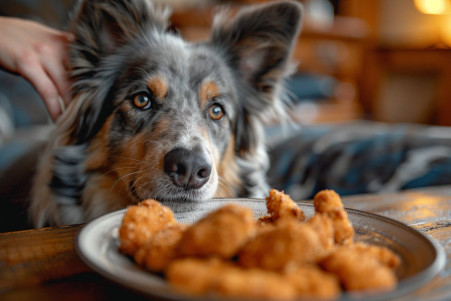Can Dogs Eat Chicken Feet? Health Benefits and Risks
5 March 2024 • Updated 4 March 2024

If you’re a dog owner, you may have wondered about the nutritional value and potential risks of feeding your pet chicken feet. In general, chicken feet are safe for dogs to eat and can even help support joint health with glucosamine and chondroitin, as well as improve dental hygiene through chewing.
To avoid choking and other hazards, make sure to feed your dog raw or dehydrated chicken feet, and always supervise your dog when they’re eating and when you’re introducing new foods.
This article takes a deep dive into the research and expert opinions on the nutritional value and safety of feeding chicken feet to dogs. It reviews studies in veterinary medicine, animal nutrition, and food science to determine the potential benefits and drawbacks.
It also offers tips on how to feed your dog chicken feet safely and responsibly so you can decide whether or not this treat is a good option for your pet. By the end, you’ll have a well-rounded understanding of this unconventional dog treat.
Can dogs eat chicken feet?
Nutritional Breakdown of Chicken Feet for Dogs
Chicken feet aren’t just a fun snack; they’re also full of nutrients that can help your dog. They’re a great source of protein, which is important for muscle health, and minerals like calcium, which is important for bone health.
According to Dogs Naturally Magazine, chicken feet naturally contain around 400 mg of glucosamine per foot, which is important for joint health and mobility. Collagen, which is found in high levels in chicken feet, is important for healthy skin, nails, and joints.
Glucosamine and chondroitin, which are found in chicken feet, are especially important for healthy joints because they help with the formation and repair of cartilage.
This makes chicken feet a great option for dogs, especially those who are at risk for joint problems. In terms of oral health, the act of chewing on the tough texture of chicken feet can help remove plaque and tartar from your dog’s teeth, which can help keep their mouth healthy.
Chicken feet are a better option than many other dog treats and supplements because they have a high bioavailability, which means that the nutrients are easily absorbed by your dog’s body. However, it’s important to feed them in moderation because they are high in cholesterol and fat, which can be problematic for dogs with certain health issues, as noted by Delishably.
While feeding your dog chicken feet can be a great way to provide them with important nutrients, it’s important to make sure that you’re balancing their intake with their other nutritional needs.
How to Make Sure Chicken Feet Are Safe for Your Dog
When it comes to making chicken feet for dogs, the most important thing to consider is safety. Kip & Twiggy’s says that chicken feet should be served raw or dehydrated to make sure that the nutrients are preserved and to avoid the potential dangers of cooking.
If you’re serving them raw, make sure to clean them thoroughly to get rid of any dirt or other contaminants. If you’re dehydrating them, you can buy them pre-made or make them at home by dehydrating them at 170–200 degrees Fahrenheit for 24 hours, according to Pawsome Recipes.
However, cooking them, especially in the oven, is not recommended because it can cause the bones to splinter, which can lead to internal injuries or blockages.
When you first introduce chicken feet into your dog’s diet, do so slowly. Kip & Twiggy’s recommends starting with one chicken foot a day for small dogs and two for larger dogs, as long as they’re not overweight or don’t have a history of pancreatitis.
And, as with any treat, always make sure to supervise your dog to make sure they don’t choke. To make sure that chicken feet last for up to two weeks, store them in an airtight container in the fridge or a cool, dark place.
By following these guidelines, you can make sure that your dog reaps the benefits of chicken feet while keeping in mind the potential dangers of any treat or dietary addition.
Understanding the Dangers: Bacterial Contamination and Digestive Issues
Despite the many claims about the advantages of chicken feet for dogs, it’s important to understand the dangers, especially bacterial contamination. Raw chicken products, including chicken feet, can be contaminated with harmful bacteria like Salmonella. Research has found that Salmonella and other pathogens are common in both homemade and commercial raw meat-based diets for dogs, which can be dangerous for pets and their human families, according to The Spruce Pets.
In addition to the dangers of bacteria, chicken feet can lead to digestive issues, especially in dogs that have sensitive stomachs or food sensitivities. Dogs with certain health issues, such as pancreatitis, may be at risk because of the fat in chicken feet. It’s important to buy chicken feet from a reputable source that guarantees their products are free from harmful additives, as noted by Natural Farm.
Anyone thinking about giving their pet raw treats should make sure to follow the FDA and veterinary recommendations, which is important for minimizing potential dangers and protecting pets.
However, pet parents need to consider the potential dangers of chicken feet and weigh them against the potential benefits and always consult with a vet to make sure their dog’s diet is appropriate for their health needs.
Chicken Feet Digestibility in Dogs
The digestibility of bones and bone-containing treats like chicken feet is an important factor in canine digestive health. A study in the Journal of Veterinary Emergency and Critical Care notes that veterinarians surgically remove some bones seen in small animal practice but manage to let others, especially gastric bone foreign bodies, dissolve, showing that digestibility can vary.
Chicken feet, which are made up of cartilage, skin, and connective tissue, are more digestible than heavier bones and are less likely to require medical intervention.
In addition, the gut microbiome of dogs is impacted by the food they eat. A study in PLOS ONE reports that there are significant differences in the fecal microbiome of dogs on raw diets, which can include chicken feet, and those on commercial diets.
The researchers conclude that raw diets can change the composition of bacterial communities, which means that pet owners should be cautious when giving these treats to dogs with sensitive stomachs or other dietary issues.
Chicken feet may have some nutritional value, including collagen and other compounds that support joint health. However, pet owners should consider the appropriateness of chicken feet as a treat on a case-by-case basis, especially for dogs with health issues. For dogs with sensitive stomachs, it may be better to stick with safer options such as specially formulated chews or dental treats, which are made to be digestible and promote good gut health.
What Vets Say and How the Government Regulates Chicken Feet Dog Treats
Veterinary organizations and professionals, as referenced by PetMD, advise against giving dogs bones, including chicken feet. Although they recognize that dogs have a natural instinct to chew on bones, they also point out that just because something is “natural” doesn’t mean it’s “safe.”
The dangers of cooked bones, which can splinter and cause injury, are well-documented. Instead, they recommend raw bones that are the right size for the dog’s head so that they can’t be swallowed whole but also can’t be swallowed after being broken into pieces.
Government agencies, such as the FDA, emphasize the need for stringent safety measures for pet treats in a consumer update cited by PetMD, which documents cases of illness and death caused by bone treats. From a government perspective, the goal is to reduce harm by requiring pet food companies to meet strict safety standards and follow guidelines.
The most important things to remember from the veterinary perspective on chicken feet are that they should be raw or dehydrated (not cooked) to prevent them from splintering and that you should buy them from reputable sources to avoid bacterial contamination, which the American Kennel Club has brought to pet owners’ attention.
These suggestions highlight the need for a nuanced view of the place of chicken feet in dogs’ diets. Dog owners need to weigh the potential benefits of supporting their dogs’ joints and dental health against the possibility of bacterial contamination and digestive issues, always keeping their dogs’ health and safety as the top priority.
Should You Give Your Dog Chicken Feet?
When deciding whether or not to give your dog chicken feet, it’s important to weigh the nutritional benefits against the potential risks. While chicken feet are high in glucosamine and chondroitin, which can help with joint health, and their texture can help with dental health, the risks are also real, ranging from bacterial contamination like Salmonella to digestive issues and the risk of bone splintering.
The safety guidelines are clear: you should feed your dog raw or fully dehydrated chicken feet and introduce them to your dog’s diet slowly. You should also always supervise your dog while they eat, and make sure that you’re getting your chicken feet from a reputable source.
And don’t forget the importance of professional advice. Make sure to talk to your vet to get personalized recommendations that take your dog’s health and dietary needs into account.
In the end, it’s up to you to weigh the pros and cons and make the best decision for your dog. While chicken feet can be a healthy addition to your dog’s diet if you follow the right precautions, it’s up to every pet owner to make sure they’re making informed, careful decisions for their furry friends.


